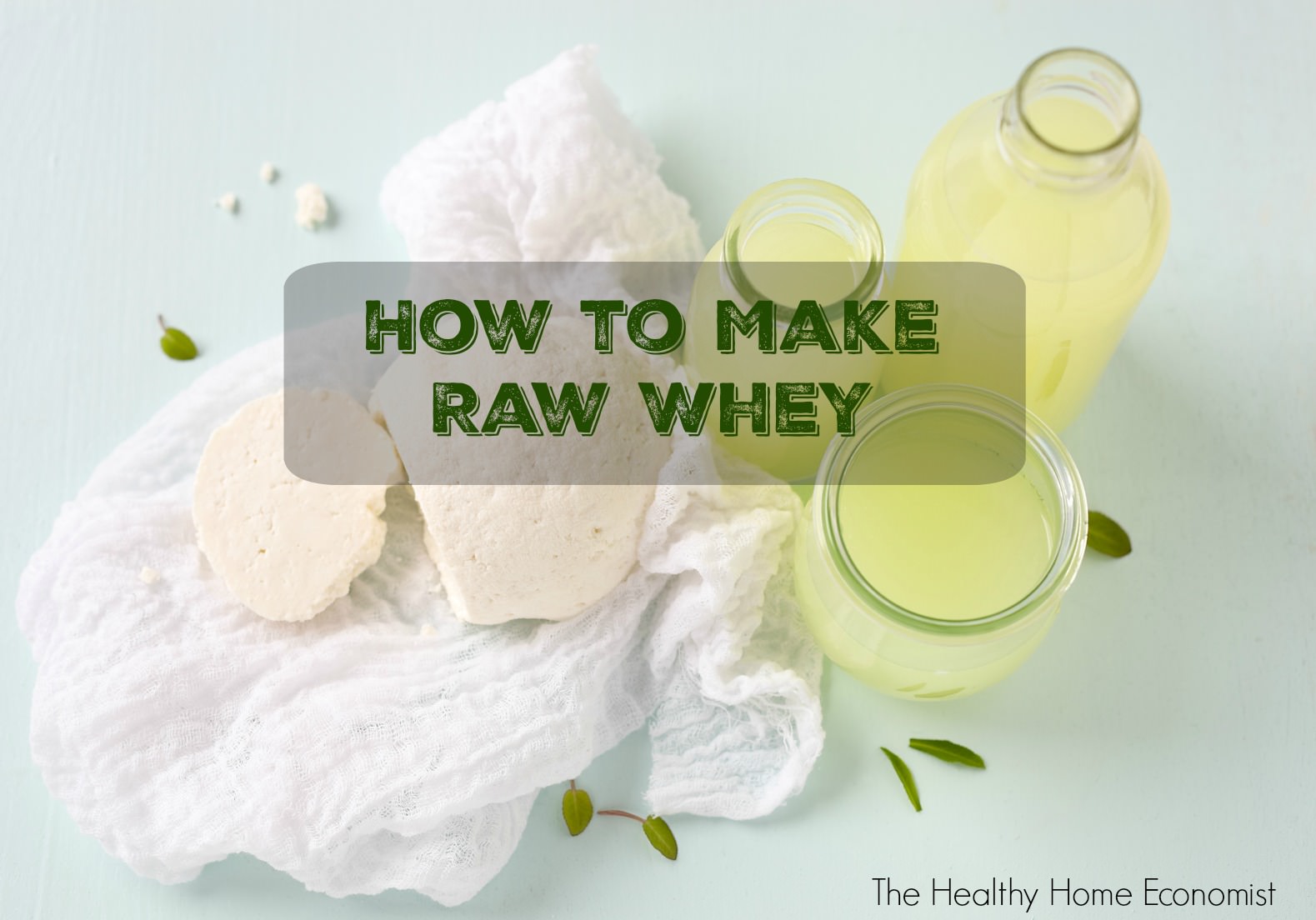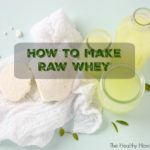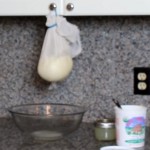How to make raw, enzyme and probiotic-rich liquid whey to use as a starter culture for all your home fermentation needs.

Do you know how to make whey from yogurt, kefir or raw milk?
A by-product of this simple technique is healthy homemade cream cheese that is loaded with enzymes and probiotics.
The recipe below describes how with visual instructions via video demonstration!
Making homemade baby formula? I recommend using this “quick whey” no straining method as the fastest and easiest approach.
How to Make Whey the REAL Way
Making real, liquid, nutrient rich, unadulterated whey in your own kitchen is a MUST step for any traditional cook to learn.
Without whey in its whole, liquid form, many other traditional recipes cannot even be attempted. You cannot buy whey from the store except in a denatured, unhealthy, powdered whey form. It is worth your time to learn what I show you in the video below.
Other video lessons on this blog show you how to use this whole food form of whey to make many delicious, healthful recipes for your family. Whey as made in the video demo below will keep up to 6 months in the refrigerator in a sealed mason jar.
If you absolutely have no access to farm fresh milk to make whole, unadulterated, enzyme rich whey, then you can use plain, organic yogurt brand from the store instead. Here are tips on how to spot the best yogurt brands.
The process is basically exactly the same thing as shown in the video.
You won’t get nearly as much whey using yogurt as clabbered, farm fresh milk, but at least you can get enough to get you started.
Wonderful Whey and REAL Cream Cheese
The raw, enzyme-rich cream cheese I make in the recipe video below is fantastic on a sprouted or sourdough bagel for breakfast. Don’t buy the Ezekiel sprouted muffins as they contain soy. This low-carb bagel recipe is another great one to try.
If you prefer to buy, these sourdough bagels are available for shipping freshly made to your door.
To make, just take your cream cheese left over from making liquid whey and add a few strawberries and a dash of dark maple syrup to taste. Mix together by pulsing a few times in your food processor. This wonderful, fresh, REAL strawberry cream cheese will last one to two weeks in the refrigerator. Another wonderful use for this healthy raw cheese is to make an easy no bake cheesecake.
No access to raw milk where you live? No problem. Check out this recipe plus video on how to separate whey from yogurt purchased from the store.
Cloudy Whey vs Clear Whey
No matter whether your whey turns out cloudy or clear, it is safe and fine to use in all your favorite recipes. This article explains why sometimes whey is cloudy compared to its usual golden color.

Raw Whey Recipe
How to separate raw, liquid whey from clabbered milk. The process also creates probiotic rich cream cheese.
Ingredients
- 1 quart raw milk preferably grassfed
- 1 large glass bowl
- 1 large rubber band
- 1 white dishtowel
Instructions
-
Allow the raw milk to sit on the counter for 1-3 days at room temperature.
-
When the milk separates into curds and whey (transforms into clabbered milk) you are ready to proceed. Note that the fresher the raw milk and the colder the temperature of your house, the longer it will take the raw milk to clabber.
-
Line a clean, large glass bowl with a clean, white dishtowel that isn’t too thick. Cheesecloth will also work, but the holes in the mesh must be very small, else the milk curds will pass through.
-
Gently pour the clabbered milk into the middle of the dish towel. Gather up the ends and fasten with a rubber band. Attach to a knob on an upper cabinet in your kitchen as shown in the picture.

-
Let the raw whey drip into the bowl underneath. This process will continue for an hour or two.
-
After the dripping stops, gently take down the hanging bag and place it into a clean bowl. Scrape out the raw cream cheese that is inside the bag, put in a container with a lid and refrigerate.
-
Pour the liquid whey from the dripping bowl into a glass mason jar, afix the lid and refrigerate.
-
Refrigerated, raw cream cheese will be good to eat for about a week. Raw whey will last several months refrigerated.
Recipe Video
How to Use Whey in Recipes
How to Make Ricotta Three Ways (plus Video How-to)
Perfect Probiotic Cottage Cheese
Cheese Making: Common Problems and Solutions








Hi. I’ve not been able to get raw milk for some time. I’ve been making mozarella with store milk at low temp, then straining off the whey to us for LF. It’s worked so far for sauerkraut. Do I need to be worried that this is ‘denatured’ or not the right enzymes in it. The store milk is not ultra pasturized.
Also have a cheese question. Do we really need all those cultures ordered online to make hard cheese? Isn’t there a way to do it with ingredients we have at home?
Thanks for your help and your awesome videos, which break everything down into simple steps!
Hi Cindy, the whey you’re using is not raw but it is still fine .. kind of the same thing that you would get if you strained the clear liquid off pasteurized store yogurt.
Definitely ok compared with powdered whey!
I am not a hard cheese expert .. hard cheeses are difficult to make in FL as you need a cool environment for aging them and there aren’t many basements here in FL as the water table is not that deep in the soil.
Hi Sarah,
I just tried making whey and cream cheese for the first time today…unsuccessful. 🙁 I’m not really sure what I did wrong. I left the milk out to clabber, but it never got chunky, even after being on the countertop for about 36 hours. So I poured it in my clean, cotton cloth anyway and let it drip. My whey has a yellowish tint, the cream cheese wasn’t chunky; it was super runny. I added blueberries and put it through the food processor, and my husband said it was awful and tasted rotten. Did I do something wrong? Is my whey ok if it’s yellow? Any advice is appreciated!
Wow! How about that!! Another strike against pasteurization. Ok, my whey looks really good. Only thing is there is a white liquid layer that rose to the top over the more transparent liquid layer. Is this white layer also whey, or do you think maybe my towel was too porous and perhaps I should skim it off?
Thanks Sarah! So excited about my whey!
You can skim the white part that came through off if you like or just leave it.
Sarah,
Is bad bacteria a concern at all? Can’t spoiled milk be harmful and make us sick? I was telling our children’s holistic pediatrician about how our diets have changed due to what we’ve been learning from WAP. He thought bad bacteria might be a concern with raw milk.
Also, I’m making the liquid whey right now for the first time. My bowl was full of whey the minute I dumped the milk in to the bowl with the tea towel. Seems to have completely seperated while clabbering. Is this okay? I saw on your video you had very little liquid whey initially.
Thanks,
Angela
Angela, milk only spoils when its pasteurized! Raw milk clabbers; it doesn’t spoil. It’s ok with getting a lot of whey right away. Sometimes the clabbering results in a complete separation, other times not. Working with Real Food is always unpredictable.
Thanks for the reassurance – that raw milk clabbers and does not spoil. This was my question too. The raw milk I used took 5 days to clabber and today the cream cheese was slightly yellowish – and I was not sure if I could use it. Well, here we introducing a new type of ‘culture’ into our life. Thanks for this great site… Perhaps you could open at some point a Traditional Food Forum… so that when you cannot answer all the questions – the advanced people in the forum can help each other? Would be great. Thanks so much for your dedication and bringing this important subject back into our lifes.
Hi Sarah,
First and Foremost, thank you for posting all those videos. Excellent work!
I’m getting ready to mix my first batch of this Homemade Baby Formula. I was able to gather most of the ingredients from Radiantlifecatalog.com, but I still have a few questions… How long can Liquid Whey be stored in the refrigerator and can it be frozen for later use? I clabbered Raw Milk from Organic Pastures Dairy. Also, what modifications can be done to the Homemade Baby Formula recipe if my newborn is constipated,? I’m using the Weston A. Price recipe that makes 36 ounces. If possible, please provide any links that might be helpful and the exact measurements. God Bless! Aileen from California
Hi Aileen, whey will last in the refrigerator about 6 months. Try making the formula with raw milk kefir or raw milk yogurt to alleviate constipation. I know of several mothers who have had success doing this.
Sarah, thank you for your prompt reply. I’m not sure I quite understand… So instead of making whey out of clabbered raw milk I should make it out of kefir or yogurt correct? OR should I omit the 2 cups of Raw milk the recipe calls for and use raw milk yogurt or kefir instead? I prepared a batch already (seems to oily) and seperate it in 3 ounce portions, is there something I can add to each portion to avoid from wasting this batch or do I have to start all over again? Aileen
I meant to substitute the raw milk portion of the recipe with raw kefir or raw yogurt.
Hi Sarah,
I clabbered my milk for 2 days — oops. I got a ton of liquid whey and my cream cheese is not liquidy at all; it’s well formed, dry and very little of it to be had. Are my end products still edible and nutrient dense?
And, as always,
Thanks so much,
Andrea
My friend and I are new to clabbered milk, so when we both made the cream cheese it tasted TERRIBLE. Just a nasty sour taste. Is it our taste buds that need to “acclimate” to the flavor or have we both missed something? Perhaps it’s in my memory that as a kid I was told not to drink the milk if it’s gone sour! Hope we can get past this, my kids too…lol.
Thanks Sarah! Your videos are incredibly helpful & I appreciate your common sense blogs that are NOT politically correct. How refreshing. I’ve been gluten free for 6 years & was so excited to discover soaking grains. It’s a new world. Thanks again.
Hi Sarah,
I had quite a bit of luck the first few times I made clabbered milk and ran it through a cheese cloth. Both the whey and the cream cheese turned out really well. However, for the past few times (when I have clabbered it for about 48 hours on the kitchen counter), I have noticed a few disturbing things. The whey and the cheese taste bitter and after a few days start to smell fruity. The cheese even turned pinkish. I assumed it was some sort of undesirable fungus and had to toss everything. I feel strongly about not wasting food (especially quality food) so this caused me to feel quite depressed. Is there something that I am not doing right? Should I pay special attention to the temperature in my kitchen or disinfect my cheese cloth several times? I am quite particular about the hygiene of the utensils and implements I use for cooking. Any suggestions would be greatly appreciated. Thanks,
Ranjani.
I am confused, I am assuming I did something wrong. I left my slightly sour milk on the counter to clabbered for over 6 hours and in the right temp but nothing happened to it. When I poured it through the tea towel not one clump of anything…can you help? Is it possible to remove the milk fats and cream? I just dont understand why it did not thicken up…
How sour is too sour for my milk to be to use. Right now it probably three weeks past the too sour to drink phase. It is golden yellow ont he bottom half and cream colored the top. Should I throw that out and wait till my current milk sours?